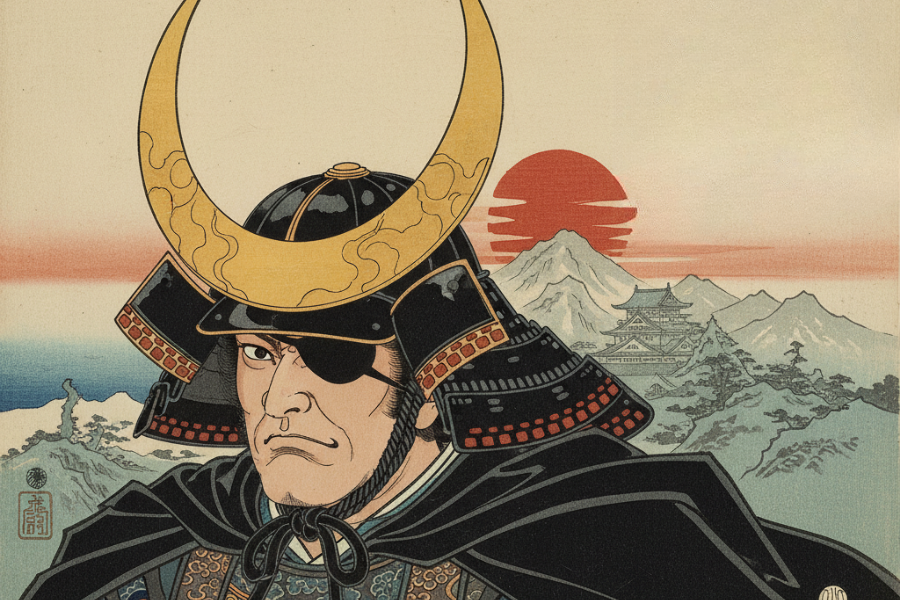Symbols of Eternal Courage: The Meaning Behind Shogun Helmets
Discover the Art, Spirit, and Stories of Japan’s Greatest Warriors
In Japan, the Shogun helmet—or kabuto—is far more than a piece of armor. It is a reflection of a warrior’s soul, philosophy, and aesthetics. Each helmet embodies the ideals of discipline, honor, and beauty that guided Japan’s legendary warriors. Today, miniature Shogun helmets recreate that legacy, allowing us to bring the spirit of the samurai into our modern lives.
This article explores seven of Japan’s most renowned warlords—Date Masamune, Oda Nobunaga, Toyotomi Hideyoshi, Tokugawa Ieyasu, Naoe Kanetsugu, and Takeda Shingen—and the hidden meanings behind their iconic helmets.
Date Masamune — The “One-Eyed Dragon” and His Crescent Moon

Few designs are as striking as Date Masamune’s jet-black helmet crowned with a gleaming golden crescent moon. The crescent represents an “ever-growing spirit” and a “light that cuts through darkness,” mirroring Masamune’s ambition to rise from the distant north and leave his mark on history. Known as the “One-Eyed Dragon,” Masamune turned adversity into strength, cultivating a visionary outlook that extended even beyond Japan.
His bold taste later inspired the word “date-mono”—a term for stylish, flamboyant individuals. In interior decor, his helmet symbolizes individuality and a silent strength that shines in minimal, modern spaces.
Shogun Helmet "Date Masamune"
Oda Nobunaga — The Fire of Innovation

Oda Nobunaga’s helmets were unlike any other—featuring fiery horns or exotic shapes reminiscent of crowns. These designs embodied his revolutionary spirit. Guided by the motto “Tenka Fubu” (Rule the realm by force), Nobunaga dismantled the feudal order and ushered Japan into a new era. His blazing-red armor symbolized the will to change, a fire that consumed the old and gave rise to the modern.
Displaying Nobunaga’s helmet in your home can serve as a powerful reminder of innovation, leadership, and courage to defy convention.
Shogun helmet "Oda Nobunaga"
Toyotomi Hideyoshi — The Golden Radiance of the Rising Sun

From peasant origins to ruler of Japan, Toyotomi Hideyoshi embodied the ultimate success story. His golden helmet, often adorned with motifs of the sun, symbolized prosperity, divine favor, and hope. Hideyoshi believed that the ruler’s role was to illuminate and protect his people—just as the sun nurtures all life.
The golden luster of his helmet remains a timeless emblem of ambition and triumph. For modern admirers, it represents the power of perseverance and self-made destiny.
Shogun helmet "Toyotomi Hideyoshi"
Tokugawa Ieyasu — Calm Strength and the Spirit of Endurance

Unlike the flamboyant designs of other warlords, Tokugawa Ieyasu’s helmet is refined and austere—black lacquered with subtle golden details. Its restrained beauty reflects Ieyasu’s philosophy: patience, discipline, and unwavering focus. After decades of hardship and defeat, he ultimately unified Japan and founded the Edo shogunate, ushering in over 260 years of peace.
His helmet represents quiet power and longevity—a symbol of enduring peace and wisdom. In any space, it radiates calm dignity.
Shogun helmet "Tokugawa Ieyasu"
Naoe Kanetsugu — The “Love” Helmet and the Spirit of Justice

Among all samurai helmets, few are as famous as Naoe Kanetsugu’s—emblazoned with a bold gold character: 愛 (ai), meaning “love.” Yet this love was not romantic—it symbolized compassion and righteousness. Kanetsugu served his lord with loyalty and ruled with benevolence, embodying the moral core of the samurai code.
His helmet stands as a timeless emblem of integrity and empathy. Today, it continues to inspire those who value harmony, sincerity, and the power of the heart.
Shogun helmet "Naoe Kanetsugu"
Takeda Shingen — The Spirit of “Fūrinkazan”

Takeda Shingen, known as the “Tiger of Kai,” was both a fierce general and a master strategist. His famous battle standard bore the words: “Swift as the wind, silent as the forest, fierce as fire, and immovable as the mountain.” His helmet, solid and commanding, expressed that same duality—discipline and ferocity held in perfect balance.
Even today, Shingen’s leadership philosophy inspires entrepreneurs and thinkers. His kabuto embodies timeless power rooted in nature’s order and unshakable resolve.
Shogun helmet "Takeda Shingen"
Displaying a Shogun Helmet — A Modern Tribute to Tradition
What once protected warriors in battle now brings peace and presence to modern interiors. Placing a miniature shogun helmet in your home is a way to honor Japanese craftsmanship and spirit. The deep lacquer, gold leaf, and delicate metalwork are testaments to the enduring skill of Japanese artisans.
Each helmet, no matter how small, carries the energy of its original wearer—a quiet reminder of courage, discipline, and grace.







